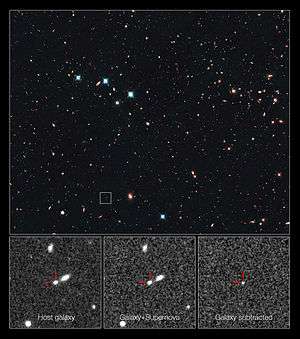SN UDS10Wil
| SN UDS10Wil | |
|---|---|
|
Record-breaking supernova SN UDS10Wil in the CANDELS Ultra Deep Survey[1] | |
| Observation data | |
| Supernova type | Ia |
| Redshift | z=1.914 |
| Distance | 10,500,000,000 light-years (3,200,000 kpc) |
| Designations | |
| SN UDS10Wil, SN Wilson | |
SN UDS10Wil (SN Wilson)[2] is a type Ia supernova, and as of April 2013, the farthest known.[3] It has a redshift of 1.914, which strongly implies that it exploded when the universe was about a third of its current size. It was discovered with the Hubble Space Telescope's Wide Field Camera 3.[1]
See also
Further reading
- David O. Jones; Steven A. Rodney; Adam G. Riess; Bahram Mobasher; Tomas Dahlen; Curtis McCully; Teddy F. Frederiksen; Stefano Casertano; Jens Hjorth; Charles R. Keeton; Anton Koekemoer; Louis-Gregory Strolger; Tommy G. Wiklind; Peter Challis; Or Graur; Brian Hayden; Brandon Patel; Benjamin J. Weiner; Alexei V. Filippenko; Peter Garnavich; Saurabh W. Jha; Robert P. Kirshner; Henry C. Ferguson; Norman A. Grogin; Dale Kocevski (2 April 2013). "The Discovery of the Most Distant Known Type Ia Supernova at Redshift 1.914". The Astrophysical Journal (published May 2013). 768 (2). arXiv:1304.0768
 . Bibcode:2013ApJ...768..166J. doi:10.1088/0004-637X/768/2/166. 166.
. Bibcode:2013ApJ...768..166J. doi:10.1088/0004-637X/768/2/166. 166.
References
- 1 2 "Hubble breaks record for furthest supernova | Press Releases | ESA/Hubble". Spacetelescope.org. 2013-04-04. Retrieved 2013-04-08.
- ↑ Jason Major (5 April 2013). "Hubble Spots the Most Distant Supernova Ever". Discovery Channel.
- ↑ Yglesias, Matthew (2013-04-04). "Exploding stars: Supernova found is most distant of its kind yet". Slate.com. Retrieved 2013-04-08.
This article is issued from Wikipedia - version of the 6/26/2016. The text is available under the Creative Commons Attribution/Share Alike but additional terms may apply for the media files.
